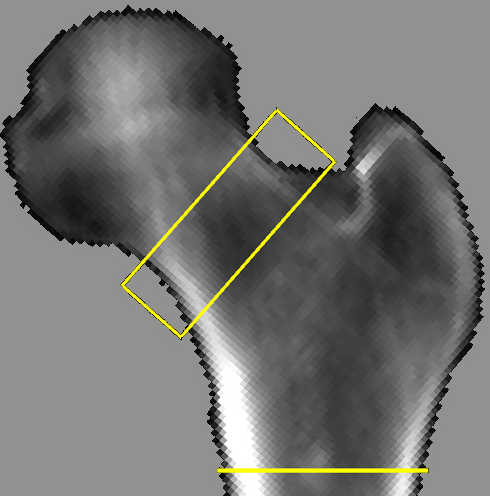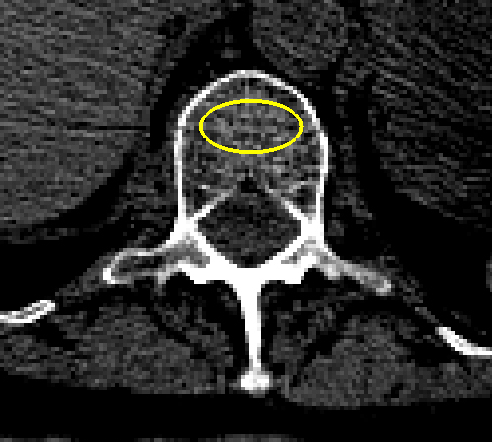The VirtuOst Measurements. The VirtuOst test measures both bone strength and BMD at the hip and/or spine, with FDA-cleared and validated interventional thresholds to facilitate clinical interpretation and decision making.
Hip and Spine Strength: VirtuOst provides a whole-bone strength (in units of newtons) of the hip and/or spine. Using non-linear finite element analysis, the result from this “virtual stress test” (see video) is an estimate of the magnitude of force required to fracture the patient's proximal femur or vertebral body under a controlled set of loading conditions — a sideways fall for the hip or a uniform compressive overload for the spine. VirtuOst's threshold levels of bone strength that define "fragile bone strength" place a patient at as high a risk of a new hip or spine fracture as does BMD-defined osteoporosis. (Research Paper)

The VirtuOst bone strength measurements. LEFT: Sectioned views of finite element models of a proximal femur (sideways fall configuration) and a vertebral body, the colors showing the local material properties as derived from the CT scan. RIGHT: the bones undergo virtual stress testing, the colors depicting where the bone tissue fails (red is more intense failure).
Hip BMD: VirtuOst provides DXA-equivalent BMD T-scores for the femoral neck and total hip regions (T ≤ -2.5 at either region indicates osteoporosis). The T-scores utilize the NHANES III Causcasian reference database, assume the young-female reference values for both sexes, and can be used with the FRAX® online calculator.

The VirtuOst DXA-equivalent hip BMD T-scores. The yellow outlines show the femoral neck and total hip regions of interest.
Spine BMD: VirtuOst provides a "volumetric" trabecular BMD at the spine, for an elliptical region of trabecular bone within the central 8–10 mm of the vertebral body. As per clinical recommendations from the American College of Radiology and the International Society for Clinical Densitometry, BMD ≤ 80 mg/cm3 indicates osteoporosis.

The VirtuOst spine BMD measurement. The yellow ellipse shows the region of interest for the trabeular volumetric BMD measurement.
Z-Score Measurements for BMD: VirtuOst provides Z-scores for all BMD measurements to enable a comparison with age- and sex-matched reference populations (NHANES III for hip, UCSF for spine). VirtuOst currently assumes Caucasian reference values. Z-scores are provided for age 20 and up.
Fracture Risk Assessment: Together with the validated interventional thresholds (see Table), the BMD measurements are used to identify osteoporosis and the bone strength measurements are used to identify fragile bone strength. Any patient having either osteoporosis or fragile bone strength at the hip or spine is classified as being at high risk of fracture. According to the Official Positions of the International Society for Clinical Densitometry, such patients should be considered candidates for pharmacologic treatment (subject to any relevant clinical factors). No DXA exam is required for confirmation.

The VirtuOst interventional thresholds for BMD and bone strength. Together with the BMD and bone strength measurements, these thresholds are used to identify osteoporosis and fragile bone strength, respectively.
Patients under the age of 65 with osteoporosis or fragile bone strength, while classified as being at "high risk" of fracture, may not be at as high a risk of fracture as are older patients because other factors influence the risk of fracture. For example, younger people have fewer falls, a key factor in the etiology of hip and wrist fractures. Thus, for younger patients (< 50 years old), the Z-scores are particularly useful and indicate how the patient directly compares against the age- and sex-matched general population.
